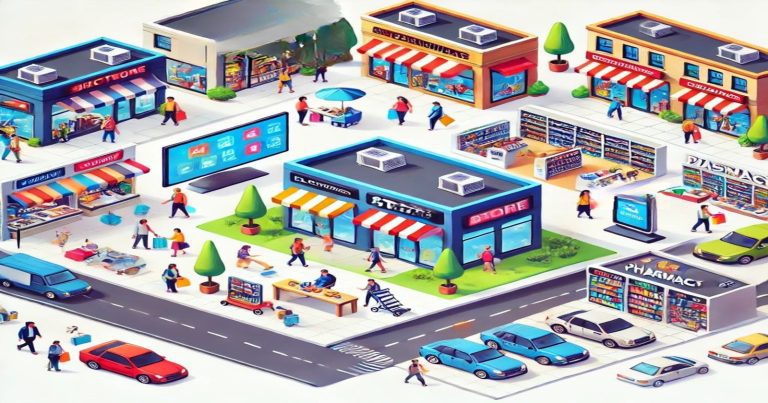The business model it supports gives a multiple-store’s essence. A multiple store is a retail format wherein different business units under the same brand name sell similar products at different locations with centralized management. Multiple stores offer convenience, assurance of brand consistency, and cost advantages through bulk purchases and standardized operation. In this article, we shall discuss the characteristics of the multiple stores, the advantages and disadvantages of the same, and the effects on the retail industry.
What is Multiple Store?
A multiple store is a chain of retail outlets operated by the same company, selling the same or nearly the same product in different locations. Uniform pricing, product selection, and branding provide consistency for the customer regardless of which store is visited. Stores are centrally managed to ensure the operation runs efficiently and saves costs.
Reliance Digital is an electronics retail store chain in India while Big Bazaar is a supermarket chain run under centralized management. D-Mart operates on the discount retail store selling groceries and household essentials. Shoppers Stop operates multiple stores selling fashion and lifestyle products, while Apollo Pharmacy operates on a wide medical retail chain selling pharmaceutical products.
Features of Multiple Store
This retail model is efficient and very popular because of the features of multiple stores. Such stores have a business plan structured in a way that there are no difficulties at any store.
- Centralized Management: One company controls the price, product assortment, and operations of all stores. Standard policies ensure that all stores are subject to the same rules and strategies.
- Uniform Product Selection: Each store sells the same type of products. The same quality of products is expected in different locations.
- Bulk Buying and Reduced prices: The product is bought in quantity, thus lowering the general cost. Lower costs during procurement allow offering price competitively to customers.
- Strong Brand Identity: Different stores are identical in terms of branding, store design, and marketing issues. Brand recognition brings trust and loyalty to the customer.
- Wide Geographical Presence: Stores are there in all regions, thereby expanding the company’s reach. Companies selectively put up stores across cities and towns to attract optimum sales.
- Standardized customer experience: A similar level of service quality and same product quality are encountered in each store. Loyalty cards and special deals are successful everywhere.
- Efficient Inventory Management: A central system tracks all the stock levels across all the stores, and automatic replenishments ensure that products are in sufficient stock.
- Cost-Effective Marketing and Advertising: The company undertakes nationwide or region-wide advertising campaigns. One advertising effort benefits all stores, thereby minimising promotional expenses.
Advantages of Multiple Store
Multiple stores offer several benefits that help businesses grow and succeed in a competitive retail market.
- Cost savings via volume purchases: The company makes volume purchases in order to get the goods sold at lower per-unit costs of goods purchased. Suppliers’ price discounts raise margins.
- Brand Loyalty and Recognition: It is trusted for its constant quality of goods and service. Good brand recognition also increases customer footfall.
- Better Market Reach: Multiple stores enable businesses to cater to a large customer base across different locations. Expansion helps in penetrating urban, semi-urban, and rural markets.
- Uniform Customer Experience: Standardized prices and product quality increase the customer’s satisfaction level. Customers can walk into any outlet, and still enjoy the same services and products.
- More negotiating power with suppliers: Large firms can negotiate better deals with manufacturers and wholesalers. This helps them offer competitive prices to customers.
- Efficient Inventory and Supply Chain Management: Stores share a standard supply chain, thereby bringing down the logistics cost. It ensures fast reordering from a centralized warehouse of products.
- High Returns: The company will experience higher sales volume because of the large number of selling points. In addition, cost-sharing between the stores enhances profit realization.
Disadvantages of Multiple Store
Despite the numerous benefits of a multi-store business, some obstacles may undermine its operations.
- High Initial Investment: When opening multiple stores, high investment is necessary to open up multiple stores. It includes store infrastructure, staffing, logistics, and advertising.
- Complex management structure: Multiple stores has more complex management structure, as Handling many stores can be difficult and demands experienced administrators. Poor coordination leads to the ineffectiveness of managing inventory and customer service.
- Higher Operational Costs: Multiple stores will involve high rent, high salary, and increased maintenance costs. Other costs incurred would be the consumption of electricity, security and logistics.
- Market Competition: Alternative shopping options available in the market include online retailers and local shops. Customers can switch to shopping online to get a better convenience and discount.
- Dependence on Supply Chain Efficiency: Any glitch in the supply chain will influence the availability of products in each store. The failure of logistics can cause shortages or overstocking.
- Employee Management Challenges: Hiring and training staff to be deployed across several locations demands much effort. When employees become dissatisfied or mismanaged, poor customer service may result.
Difference Between Departmental Stores and Multiple Shops
Departmental stores and multiple shops are two of the most common retail businesses. However, each is unique in its way. Departmental stores offer a whole range of products under one roof, whereas multiple shops focus on selling specific products through a chain of outlets. Here are a few differences.
| Basis | Departmental Stores | Multiple Shops (Chain Stores) |
| Ownership | Operated as a single large unit under one management. | A group of shops owned by the same company but managed separately. |
| Product Range | Offers a wide variety of products across different categories. | Focuses on selling specific types of products, often in the same category. |
| Location | Usually located in major city centres or large commercial areas. | Spread across various locations, including small towns and neighbourhoods. |
| Pricing Policy | Flexible pricing with occasional discounts and offers. | Fixed pricing policy, with little or no room for bargaining. |
| Shopping Experience | Provides a spacious, comfortable shopping environment with additional services. | The simple layout is focused on quick, efficient transactions without extra services. |
Multiple Store FAQs
1. What is multiple store in retail?
A multiple store is a retailing business model in which a single company owns and operates multiple outlets in different places, selling similar products under the same brand.
2. Which one is better chain stores or multiple shops?
Both chain stores and multiple shops have pros and cons, depending on the nature of the business and its purpose.
3. What are some of the disadvantages of multiple store businesses?
It involves high initial investment, complex management, and quality control issues and is generally more expensive to operate.
4. How do multiple stores reduce costs?
It benefits from the economy of bulk purchases, a central supply chain, and cost-sharing across outlets that cuts across all expenses.
5. What are a few examples of multiple store businesses in India?
Some examples of multi-store businesses in India are D-Mart, Reliance Digital, Apollo Pharmacy, Shoppers Stop, and Big Bazaar.


